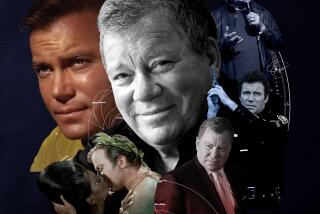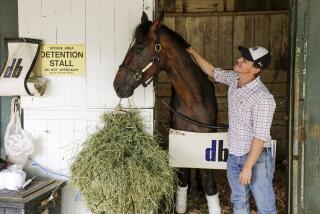A Gentler Way to Tame a Horse
- Share via
ARTHUR, Neb. — With a well-trimmed mustache, crisp white shirt and worn leather chaps over jeans, Tim Schaack is easily pegged as a cowboy.
But as he calmly leads a young horse around a paddock at Haythorn Ranch near Arthur, in western Nebraska, it becomes clear that the popular image of the Western horseman is due for revisions.
Gone are the days when the only way to get a horse to take a saddle was for a cocky young man to jump on the animal’s back and hold on until the horse gave up.
“I feel I can get so much more from the horse the more ... I understand about how his inner feelings are and how his mind works,” said Schaack, horse trainer on the sweeping ranch, home to about 900 horses throughout the year.
First brought to the attention of the American public with the 1998 Hollywood film “The Horse Whisperer,” this gentle form of horse training rooted in the West has slowly become the standard.
Over the last decade, it has grown to influence just about every discipline of horse training, including the tony world of English-style riding and the subtle precision of show horses. The race track industry may be one holdout, said Erin Petersen, equine lecturer at the University of Maryland.
The technique, known generally as natural horsemanship, is shared throughout the nation and the world by professional trainers and the elder statesman of this type of horse training -- Ray Hunt.
Some professional trainers sell training videos and books. Most trainers hold clinics where, for a few days, riders can get hands-on experience.
“There are a lot of different people out there that all teach the basic thing, which is that you want the horse to want to do what you’re asking it to,” Peterson said. “So you’re using the horse’s own natural communication, which is through body language, to actually train the horse.”
Horses that are trained using nonforceful techniques tend to be more responsive to and respectful of their riders, Petersen said.
Not everyone agrees. After 15 years as a professional horse trainer, Paul Gallegos of Ainsworth said he had found that force, such as grabbing a tighter hold of the reins or using more spur, was sometimes necessary.
He noted that the key was balance, adding that some trainers who used forceful techniques may have gone too far, while natural horsemanship may be too far to the opposite extreme.
Although various forms of natural horsemanship date back more than 2,000 years to the writings of the Greek philosopher and cavalryman Xenophon, the man usually credited with bringing this type of horse training to the United States is Tom Dorrance, who died last year.
Hunt learned his method of training from Dorrance in California about 40 years ago. Now Hunt, who is based in Idaho, holds 10 to 20 clinics per year in the United States, Canada, Europe and Australia.
During the clinics, Hunt trains riders to feel out the needs and abilities of the horse while teaching it such skills as taking its first ride or learning to turn. He said being too forceful with a horse will only scare it into trying to protect itself.
Schaack, originally from South Dakota, began learning his training technique about 10 years ago by reading articles and riding with trainers he admired, including Hunt.
Learning the method has helped Schaack train horses with greater ease and effectiveness, he said. “You don’t just decide now when you go out and saddle up your horse, ‘OK, now I’m going to be peaceful and be alert to this horse.’ It makes you more aware of everything around you,” he said.
Being alert to the horse means watching how it moves, where it holds its head and how it responds to the actions of the rider. Although these changes can easily be overlooked, once a rider learns the ways in which a horse physically expresses its feelings, recognizing them can be like reading the face of an old friend, Schaack said.
Building a feeling of trust and friendship between the rider and animal is crucial, Schaack said.
“A horse that trusts the rider and understands that and really believes that the rider isn’t going to put him in any danger -- it’s about impossible to scare one of those horses,” he said.
As Schaack works with a 3-year-old colt at Haythorn Ranch, he first touches the animal in various spots with the saddle blanket and later a rope to get it used to the sensation -- even though the colt has already made its first ride.
Initially, the colt’s expression tightens up and it raises its head to get a better look at what’s going on. As it gets used to the situation, it relaxes and begins to work its lips, showing that it feels that maybe it’s not going to be all that bad, Schaack said.
Although most colts can be ridden after the first training session, this one took two or three sessions, Schaack said.
He said it was the more challenging horses, like the 3-year-old, that made him search for a new technique a decade ago.
“It always bothered me why there was some of those horses that I could feel there was greatness within ... and I couldn’t make them better. And it was because I wasn’t aware of what the horse was feeling and what his problem was.”
Figuring out what is worrying a horse may take extra time, but a few additional hours are well worth it, he said.
Cowboys are long used to back-breaking, dirty, 18-hour days spent branding animals, training horses and herding cattle -- things that Schaack said were left out of the cowboy stereotype.
Perhaps in the end, the image of a tough guy atop a bucking bronco caught on, Schaack said, “because they wouldn’t have sold many movies just watching cowboys work hard everyday.”
More to Read
Sign up for Essential California
The most important California stories and recommendations in your inbox every morning.
You may occasionally receive promotional content from the Los Angeles Times.










